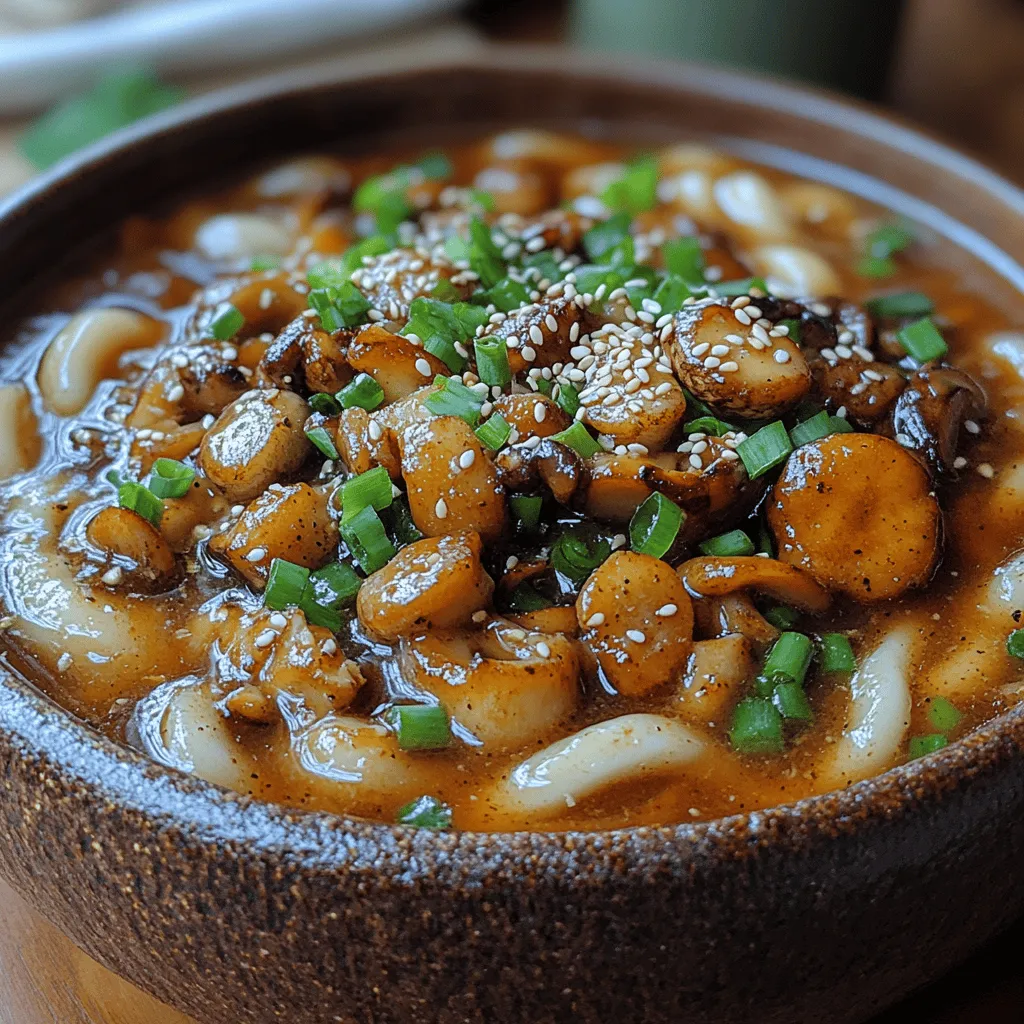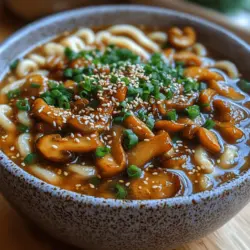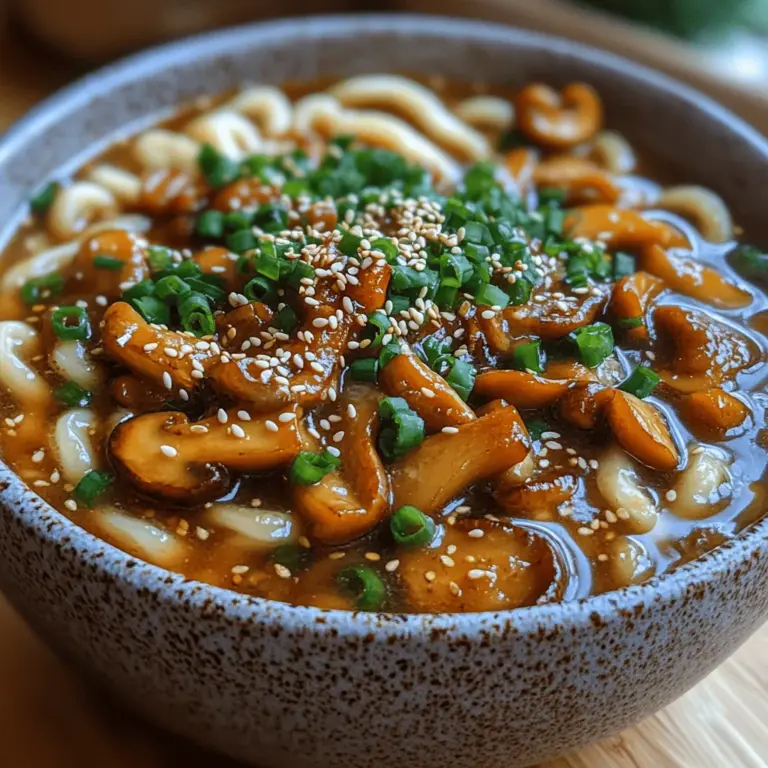Introduction
Earthy Miso Mushroom Udon is not just a dish; it’s an experience that brings together the rich culinary traditions of Japan with the umami-packed flavors of miso and the hearty texture of udon noodles. This dish embodies the essence of Japanese comfort food, offering warmth and satisfaction in every bite. With its delightful combination of tender mushrooms, chewy udon noodles, and a savory miso broth, Earthy Miso Mushroom Udon is a delightful choice for both weeknight dinners and special occasions.
The roots of this recipe can be traced back to the Japanese love for noodle dishes, where udon, a thick wheat noodle, is often featured in a variety of broths and sauces. Miso, a fermented soybean paste, adds depth and complexity, making this dish not only delicious but also nutritious. With its focus on fresh produce and quality ingredients, Earthy Miso Mushroom Udon stands out as a dish that celebrates seasonal bounty and highlights the importance of mindful cooking.
As you prepare to embark on making this flavorful udon dish, anticipate the delightful interplay of textures—the chewy noodles, the tender yet meaty mushrooms, and the smooth, rich miso broth. Together, these elements create a comforting bowl that’s perfect for any occasion, whether you’re looking to warm up on a chilly evening or impress guests at your next dinner party.
Understanding the Ingredients
To create the perfect Earthy Miso Mushroom Udon, understanding the ingredients and their qualities is essential. Each component plays a crucial role in delivering the overall flavor and texture of the dish.
Fresh Produce
The foundation of any great udon dish lies in the fresh produce used. For this recipe, mushrooms are the star ingredient, and a variety of types can be used to enhance the earthy flavors. Shiitake mushrooms, with their rich umami taste, are a popular choice, but feel free to experiment with other varieties like oyster mushrooms or cremini for added complexity. Each type of mushroom brings its unique flavor profile, contributing to the overall depth of the dish.
In addition to mushrooms, fresh vegetables such as bok choy, green onions, and carrots add color and nutrition. Bok choy, with its crisp texture and mild flavor, pairs beautifully with udon and helps create a well-rounded dish. Green onions provide a fresh, sharp contrast, while carrots add a touch of sweetness.
Proteins
While the dish can easily be made vegetarian or vegan, adding protein can enhance the meal’s heartiness. Tofu is an excellent option, soaking up the miso flavors and providing a satisfying bite. Firm or extra-firm tofu works best, as it holds its shape during cooking. For a non-vegetarian option, thinly sliced chicken or pork can be included, marinated in a miso or soy sauce mixture to complement the other flavors in the dish.
Spices and Seasonings
Miso paste is the key seasoning in this dish, delivering a complex umami flavor that elevates the broth. There are various types of miso—white, yellow, and red—each varying in taste and saltiness. For a balanced flavor, white or yellow miso is recommended, as they tend to be milder and sweeter.
Other essential seasonings include soy sauce, which adds saltiness and depth, and sesame oil, providing a nutty aroma that rounds out the dish. Fresh ginger and garlic are also important components, their aromatic qualities infusing the broth with warmth and richness.
Importance of Ingredient Quality
When it comes to making Earthy Miso Mushroom Udon, the quality of your ingredients can significantly impact the final dish. Fresh, seasonal produce brings vibrant flavors and textures, making the dish more enjoyable. Additionally, using high-quality miso and soy sauce ensures that the umami flavors shine through, preventing the dish from tasting flat or overly salty. Whenever possible, opt for organic or locally sourced ingredients to enhance the overall quality of your meal.
Seasonal Variations in Ingredient Selection
One of the beauties of Earthy Miso Mushroom Udon is its versatility. Depending on the season, you can easily switch out vegetables to make the dish appropriate for the time of year. In the spring, you might incorporate asparagus or snap peas; in the summer, zucchini and bell peppers can add color and flavor; while in the fall, root vegetables like sweet potatoes or kabocha squash can be a delicious addition. Adapting the recipe to include seasonal produce not only enhances the taste but also supports local farmers and sustainable eating practices.
Preparation Steps
Preparation is key to a successful cooking experience, and mise en place, which means “everything in its place,” is essential for this recipe. By organizing your ingredients and tools beforehand, you’ll streamline the cooking process and ensure that everything flows smoothly.
Overview of Preparation Techniques
To prepare your Earthy Miso Mushroom Udon, begin by gathering all your ingredients and utensils. This includes measuring out your miso paste, soy sauce, sesame oil, and any other seasonings you plan to use. Having everything ready to go will make the cooking process more efficient and enjoyable.
Preparing Vegetables
Start by washing and slicing your vegetables. For the mushrooms, remove the stems if necessary and slice them into thick pieces to maintain their texture during cooking. Chop the bok choy into bite-sized pieces, separating the greens from the stems, as the stems will take longer to cook. Julienne the carrots for even cooking and visual appeal.
Marinating Proteins
If you’re using tofu or any protein, marinating it can infuse additional flavors. For tofu, press it to remove excess moisture, then cut it into cubes. In a small bowl, mix together some miso paste, soy sauce, sesame oil, and a splash of water to create a marinade. Toss the tofu cubes in the marinade and let them sit for at least 15-30 minutes. If you’re using meat, slice it thinly and marinate it in the same mixture for enhanced flavor.
Measuring and Organizing Spices
Next, measure out your spices and seasonings. Having them organized in small bowls or containers will save you time during the cooking process. This includes your miso, soy sauce, sesame oil, minced garlic, and grated ginger. Remember to keep your stir-frying oil ready as well—this could be vegetable oil, canola oil, or even a light sesame oil for added flavor.
Cooking the Dish
Once you’ve prepared all your ingredients, it’s time to cook your Earthy Miso Mushroom Udon. This step involves using various cooking methods to achieve the perfect balance of flavors and textures.
Overview of Cooking Methods Used
The primary cooking methods for this dish include sautéing and boiling. Sautéing the mushrooms and vegetables will bring out their natural flavors and caramelization, while boiling the udon noodles will achieve the desired texture.
Sautéing, Roasting, Boiling, etc.
Begin by heating a large pot over medium-high heat and adding a splash of oil. Once the oil is hot, add the marinated tofu (or meat) and sauté until golden brown and cooked through. Remove the protein from the pot and set it aside.
In the same pot, add a bit more oil if necessary, and toss in the mushrooms. Sauté them for a few minutes until they begin to release their moisture and turn golden. Next, add the bok choy stems and carrots, cooking until they are tender-crisp. Finally, add the bok choy greens and sauté for an additional minute until they wilt.
While the vegetables are cooking, prepare the udon noodles according to package instructions. Typically, this involves boiling them in a separate pot of water for about 8-10 minutes until they are tender but still chewy. Drain and rinse the noodles under cold water to stop the cooking process.
Importance of Cooking Times and Temperatures
Cooking times and temperatures are critical in achieving the right texture and flavor in each component of the dish. Overcooking the mushrooms can lead to a mushy texture, while undercooked vegetables may not provide the desired bite. Aim for a balance: the mushrooms should be tender but not falling apart, and the vegetables should retain some crunch.
Tips for Achieving the Perfect Texture and Flavor
To achieve the perfect flavor, it’s essential to taste your broth as you go. Once your vegetables are sautéed, add a bit of water or vegetable broth, followed by the miso paste and soy sauce, stirring to combine. Bring the mixture to a gentle simmer, allowing the flavors to meld together. If the broth seems too thick, add additional liquid until you reach your desired consistency.
Visual Cues for Doneness
As you cook, look for visual cues to determine doneness. The mushrooms should be lightly browned, and the bok choy should be wilted but still vibrant green. The tofu or meat should be golden and cooked through, while the udon noodles should be chewy yet tender. This attention to detail will ensure that your Earthy Miso Mushroom Udon is not only flavorful but also visually appealing.
With these preparation steps complete and an understanding of the cooking methods, you’re well on your way to creating a delicious bowl of Earthy Miso Mushroom Udon. This dish promises to be a highlight of your culinary repertoire, combining fresh ingredients with traditional techniques to deliver a memorable dining experience.

Flavor Profile and Pairings
The Earthy Miso Mushroom Udon is a delightful dish that combines rich umami flavors with a hint of sweetness and a touch of nuttiness. The base of miso paste adds depth, while the sautéed mushrooms contribute a savory, earthy note. When paired with the chewy texture of udon noodles, each bite offers a satisfying contrast, making it a truly comforting meal.
To elevate the flavors of this dish, consider adding some side dishes that complement its umami-rich profile. A simple cucumber salad dressed with rice vinegar can provide a refreshing crunch that balances the dish’s depth. Alternatively, a light miso soup can enhance the miso theme while offering a warm, brothy addition to the meal.
For beverage pairings, consider serving a chilled sake to enhance the meal’s umami character. The delicate notes of sake harmonize beautifully with the miso and mushrooms, creating a cohesive dining experience. If you prefer non-alcoholic options, a lightly brewed green tea can also work wonders, cleansing the palate and providing a subtle grassy note.
Nutritional Benefits
The Earthy Miso Mushroom Udon is not only delicious but also packed with nutritional benefits. Miso paste, a fermented soybean product, is rich in probiotics, which can support gut health. It also contains essential amino acids, vitamins, and minerals, making it a nutrient-dense ingredient.
Mushrooms, the star of this dish, are low in calories and high in fiber, which aids digestion. They are also a good source of antioxidants and essential nutrients such as selenium, potassium, and vitamin D. Udon noodles, while primarily carbohydrate-based, provide energy and can be made from whole grains for added fiber and nutrients.
Incorporating this dish into a balanced diet can be easy. It offers a good mix of carbohydrates, protein, and healthy fats, especially when paired with vegetables or protein sources such as tofu or tempeh. This versatility allows the Earthy Miso Mushroom Udon to fit into various dietary preferences, from vegetarian to vegan.
Cultural Significance
Udon noodles have a rich history in Japanese cuisine, dating back over a thousand years. Originally brought to Japan from China, they have since evolved into a staple food, often enjoyed in a variety of preparations, including soups and stir-fries. Miso, on the other hand, has been used in Japanese cooking for centuries, originating in ancient China and later becoming integral to Japanese culinary traditions.
Variations of udon can be found across different regions of Japan, each with its own unique twist. For example, in the Kagawa Prefecture, you can find a specialty called “Sanuki udon,” known for its firm texture and served with various toppings. Similarly, the use of miso varies regionally, with different types of miso paste producing diverse flavors and colors.
Personal anecdotes surrounding this dish often highlight the warmth and comfort it brings. Many home cooks enjoy preparing udon during colder months or as a family meal, emphasizing the communal aspect of sharing food. The simplicity of the recipe makes it accessible for home cooks, encouraging creativity and personalization in the kitchen.
Serving Suggestions
Presentation can enhance the overall enjoyment of the Earthy Miso Mushroom Udon. To serve this delicious dish, use a deep bowl that allows the noodles and broth to shine. After ladling the udon into the bowl, artfully arrange the sautéed mushrooms on top, allowing their texture to be highlighted.
For garnishing, consider adding a sprinkle of sliced scallions or chives for a pop of color and freshness. A few sesame seeds can also add a nutty crunch, enhancing the dish’s overall appeal. If desired, a drizzle of chili oil or a few drops of sesame oil can provide an additional layer of flavor and a hint of heat.
Best practices for serving include ensuring that the dish is piping hot when it reaches the table. This not only enhances the flavors but also creates a cozy atmosphere. Encourage diners to mix the ingredients together before enjoying, allowing the flavors to meld and ensuring that every bite is as delicious as the last.
Storage and Reheating
To properly store leftovers of your Earthy Miso Mushroom Udon, it is best to separate the noodles from the broth. Place the udon noodles in an airtight container and store them in the refrigerator for up to three days. The broth can be stored in another container, also sealed tightly. This prevents the noodles from becoming overly mushy as they absorb the liquid.
If you wish to freeze the dish, it is advisable to freeze the broth separately. Udon noodles can be frozen as well, but they may lose some texture upon thawing. When reheating, it is best to do so gently. For the broth, pour it into a saucepan and heat over medium heat until hot but not boiling, which can help preserve the flavors. For the noodles, you can briefly plunge them into boiling water for a minute before adding them to the reheated broth.
When combining everything back together, ensure you stir well to allow all flavors to meld. This method of storage and reheating will help maintain the integrity of your Earthy Miso Mushroom Udon.
Conclusion
The Earthy Miso Mushroom Udon is more than just a meal; it’s an experience that brings warmth and comfort to the table. With its rich umami flavors, nutritional benefits, and cultural significance, this dish is a perfect addition to any culinary repertoire. It not only allows for creativity in the kitchen but also serves as a wonderful way to share meals with family and friends.
Encouragement to try making this recipe is rooted in the joy of cooking and the satisfaction that comes from creating a dish that is both healthy and hearty. As you experiment with flavors and presentation, you’ll find that cooking becomes a delightful journey of discovery. So gather your ingredients, embrace the process, and enjoy the delightful warmth of Earthy Miso Mushroom Udon in your home.

